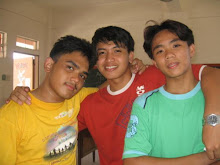Shotokan is one of the five traditional karate styles, the others being Gōjū-ryū, Shitō-ryū, Shōrin-ryū and Wadō-ryū. Although it began as a unified karate school that developed into the Japan Karate Association, Shotokan now exists as several independent organizations.
Philosophy
Gichin Funakoshi laid out the Twenty Precepts of Karate,[2] (or niju kun[3]) which form the foundations of the art, before his students established the JKA. Within these twenty principles, based heavily on Bushido and Zen, lies the philosophy of Shotokan.
The principles allude to notions of humility, respect, compassion, patience, and both an inwardly and outwardly calmness. It was Funakoshi's belief that through karate practice and observation of these 20 principles, the karateka would improve their person.[1]
Many shotokan students typically recite the Dojo kun at the end of each class:
- Hitotsu, jinkaku kansei ni tsutomuru koto.
(First, seek perfection of character.) - Hitotsu, makoto no michi o mamoru koto.
(First, protect the path of truth.) - Hitotsu, doryoku no seishin o yashinau koto.
(First, foster the spirit of effort.) - Hitotsu, reigi o omonzuru koto.
(First, respect the rules of etiquette.) - Hitotsu, kekki no yū o imashimuru koto.
(First, guard against impetuous courage.)
The prefix Hitotsu (variously translated as one or first) is used to indicate that all five principles are equally important. The JKA uses this version:
- Seek perfection of character.
- Be faithful.
- Endeavor .
- Respect others.
- Refrain from violent behavior.((fact}}
Funakoshi also wrote: "The ultimate aim of Karate lies not in victory or defeat, but in the perfection of the character of the participant."
Shotokan training is usually divided into three parts: kihon (basics), kata (forms or patterns of moves), and kumite (sparring). Techniques in kihon and kata are characterized by deep, long stances that provide stability, enable powerful movements, and strengthen the legs. Strength and power are often demonstrated instead of slower, more flowing motions. Kumite techniques mirror these stances and movements at a basic level, but progress to being more flexible with greater experience. Shotokan can be regarded as a 'hard' and 'external' martial art.
Origins
Gichin Funakoshi had trained in both of the popular styles of Okinawan karate of the time: Shorei-ryu and Shorin-ryu. After years of study in both styles, Funakoshi created a simpler style that combined the ideals of the two.[1] He never named his style, however, always referring to it simply as "karate." Funakoshi's karate reflects the changes made in the art by Ankō Itosu, including the Heian/Pinan kata series. Funakoshi changed the names of the kata in an effort to make the "foreign" Okinawan names more palatable to the then-nationalistic Japanese mainland.
In the 1920s, Funakoshi adopted the Kyū/Dan rank system and the uniform (keikogi) developed by Kano Jigoro, the founder of judo.This system uses colored belts (obi) to indicate rank. Originally, karate had only three belt colors: white, brown, and black (with ranks within each). The original belt system, still used by Shotokan Karate of America,[13] is:
- Ungraded: White
- 8th kyū–4th kyū: white
- 3rd kyū–1st kyū: brown
- Dan grades: black
Funakoshi awarded the first 1st dan (初段; shodan) Shotokan karate ranks to Tokuda, Otsuka, Akiba, Shimizu, Hirose, Gima, and Kasuya on 10 April 1924. Hong Hi Choi, a key figure in the development of taekwondo, studied Shotokan karate during the Japanese occupation of Korea during the first half of the 20th century.

No comments:
Post a Comment